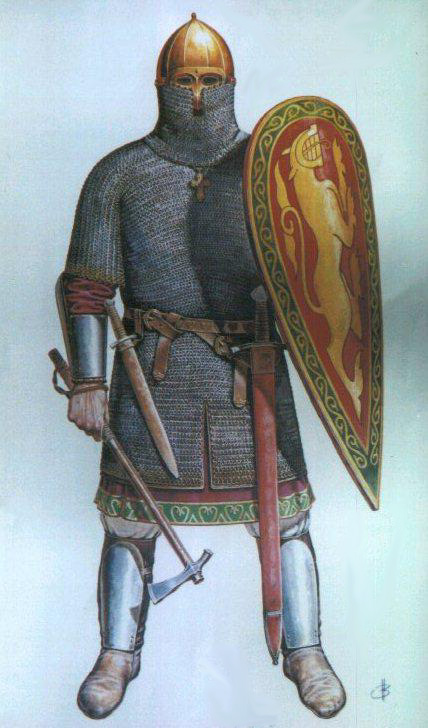RUSSIAN
MEDIEVAL ARMS AND ARMOR
John Sloan
|

|
|
Our cover illustration is of Alexander Nevski, prince of Novgorod and later
Grand Prince of Vladimir. He defeated the Swedish invaders on the Neva River in
1240 and then the Teutonic Knights at Lake Chud in 1242. He is shown wearing a
long kol'chuga, single-piece buturliki, naruchi, and an
early sholom. He carries a chekan in his right hand and is
wearing both a myech and nosh on his belt. He carries the typical
Varangian kite (almond) shaped shield. This painting was commissioned by John
Sloan and created by Zubov in St. Petersburg, Russia. (Prints are available.) The following are the principal
references used to compile this information. Vinklyer, P, von Oruzhiye,
St. Petersburg, 1894. Fedorov, B. G. Voorushyeniye russkoi armii za XIX
stolyeniye, St Petersburg, 1911. Dyenisov, M. M., Porshnov, M. E.
Russkoye Oruzhiye XI - XIX vekov. Moskva, 1952. S. K. Bogoyavlyeiskii,
"Vooruzhyeniye Russkikh voisk v XVI - XVII vekov." in journal of
Academy of Science of the USSR, Institute of History. Kirpichnikov, A., and A.
Yurasovskii, Russkye Dospyekhi X - XVII vekov, Moscow, 1991.
Istorichyeskoye opisaniye odyezhdi i vooruzhyeniya rossieskikh' voisk' c
risynakami sostavlyennoye po bisochaishfmy povyel'niyu. chast' pyervaya, St
Petersburg, 1899. Tarassuk, Leonid, Claude Blair, The Complete Encyclopedia
of Arms and Weapons, Bonanza Books, Italy, 1986. The B/W illustrations are
from Viskovatov's massive work on the history of Russian uniforms. The color
illustrations are of the members of the Alexander Nevski Film and Pagent
Society. The best recent reference is Mikhael Gorelik's Warriors of
Eurasia, Montvert Publications. See also his articles in Tseghaus
magazine and the pamphlet Bitva na Kalke 31 May 1223, Izdatel'stvo
Izograf, Moskva, 1994. There are a few, but excellent, illustrations and
extensive text describing how kol'chugi and some other types of armor were
manufactured in Sbornik nauchnikh trudov po materialam gosudarstvennoi
oruzheinoi palata - Gosudarstvennaya oruzhyenaya palata moskovskogo
kremlya, published in 1954 by Iskusstvo, Moskva. To return to or access the
main page on Russia please go to
Xenophon. We now have
many photos of the collection of medieval arms and armor in the
Kremlin armory museum.
And there are a few items of medieval armor in the
Artillery Museum in St
Petersburg.
Table of Contents
Part I - General discussion
Part II - Principal Terms with illustrations of
individual items.
Part III - Illustrations of individuals wearing
complete armor.
Part IV -Weapons Table - showing usage by century.
Cover Frontspiece to the edition of the
Viskovatov collection published in Russia in 1890's.
Historians divide the development of arms and armor in Russia into three
periods. The first or "Norman" period from the 9th to the 13th
centuries is characterized by the use of the kolchuga - mail shirt - for
body armor; the mech - long straight sword - as offensive weapon;
theshelm - round, hemispherical iron cap - for helmet; and the long,
almond shaped "kite" shield.
The second period began in the 13th century with a transition to a more
Eastern, Mongol and Tatar-influenced style of weaponry during which sabers,
round shields and eastern style body armor appeared in general use.
At the beginning of the 17th century the third period saw the gradual
introduction of Western influences and the Oriental styles wained slowly.
Russians categorize medieval arms and armor as follows:
Offensive: kolushchyeye - thrusting weapons, (including sabel,
konchar, mech, nosh, and kindjal); metatel'noye - shooting
(launching) weapons (including kolchan, djid, naluch, saadak, samostrel
and sulitsa ); ru'yashchyeye - chopping weapons (including
berdysh, sovna and rogatina); and udarnoye - striking
weapons (including bulava, chekan, klevets, palitsa, shestoper, and
topor).
Defensive: dospekh orbronya - body armor (including pantsir,
baidana, bakhteretz, kalantar', kol'chuga, kuyak, nagavits, tyegilyai,
yushman and zertsalo); sholom or shlyem - head or neck
protection - helmet (including barmitsa, litchina, misyurka, shishak,
shlyem, yalovets and yerikhonka); and the shchit - shield
(including the tarch).
Here is an illustration of a wide variety of arms and armor worn and
carried by members of the St. Petersburg, Alexander Nevski Society, now renamed
"Druzhina". Varangians For more photographs
of this redoubtable group go to Part III. An extensive list of web sites on all
aspects of military history is located in the military history section of the
main Xenophon web site.

